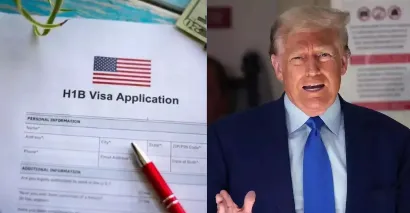Key Highlights
- The $100,000 Fee Structure and Implementation
- Tech Industry Impact and Corporate Response
- University and Research Institution Challenges
- Proposed Lottery System Overhaul
- Congressional Reform Proposals and Legislative Activity
- Global Competition and Economic Implications
- Business Impact Analysis and Future Outlook
- Conclusion
The Trump administration's decision to impose a massive $100,000 fee on H-1B visa applications has sent shockwaves through America's tech industry and immigration policy circles. This unprecedented move represents the latest chapter in ongoing debates about high-skilled immigration reform, raising questions about whether such drastic measures address underlying systemic issues or create new barriers to attracting global talent.
The Trump administration's announcement of a $100,000 fee for H-1B visa applications has created unprecedented turbulence in America's high-skilled immigration landscape. This dramatic policy shift, effective September 21, 2025, represents far more than a simple fee adjustment – it signals a fundamental reimagining of how the United States approaches skilled worker immigration at a time when global competition for talent has never been fiercer.
The $100,000 Fee Structure and Implementation
The new fee is only extended to the H-1B petitions of beneficiaries outside the United States, which is a major contrast to the earlier cost structures that were between 2,000 and 5,000 dollars, depending on the size of the employer. This is a 2,000 percent growth that has taken employers in various sectors by surprise.
The implementation details to be taken into consideration are the 12-month expiration date, exemptions of posts that are considered to be in the national interest, and coverage of already submitted petitions. Legal challenges have already been raised by healthcare organizations, educational facilities, and religious organizations, which claim that the fee poses an insurmountable obstacle in attracting the necessary staff.
|
Previous H-1B Fee Structure |
New Fee Structure (2025) |
|
Small employers: $2,000-3,000 |
All employers: $100,000 |
|
Large employers: $4,000-5,000 |
Plus existing government fees |
|
Universities: Often exempt |
No exemption from new fee |
Read More: Difference Between a Visa and a Passport
Tech Industry Impact and Corporate Response
Major technology companies face the most severe disruption from these changes, given their heavy reliance on H-1B visas for skilled workers. Amazon secured 10,044 H-1B visa approvals in the first half of 2025, followed by Tata Consultancy Services with 5,505 approvals. These numbers underscore the significant financial impact companies now face.
The fee particularly affects Indian IT service companies, which historically secured approximately 13% of all H-1B visas issued. Companies like TCS, Infosys, Wipro, and HCL Technologies must now weigh the substantial costs against business needs, potentially altering their operational strategies in the US market.
Tech leaders, including former H-1B holder Elon Musk, have historically advocated for expanded high-skilled immigration programs. The current restrictions force a reevaluation of recruitment strategies and may accelerate offshore operations development.
University and Research Institution Challenges
The H-1B caps have been exempted from universities, which are under special pressure in the new model. These changes are especially susceptible to twenty-five of the most prominent universities in the US, as they are now in a competition with other countries worldwide to recruit the best academic talents in areas such as artificial intelligence, biotechnology, and advanced research.
The policy gives what immigration professionals refer to as a naked tax on their pipeline of hiring international researchers and faculty. This may have a serious influence on the research capacity and graduate studies in America that require global skills.
Read More: Visa-Free Countries for Indians to Explore Global Travel
Proposed Lottery System Overhaul
Beyond the fee increase, the administration plans to replace the current random lottery system with a wage-based selection process. Under proposed rules, employers would receive lottery entries based on salary levels:
-
Level IV Pay: 4 lottery entries
-
Level III Pay: 3 lottery entries
-
Level II Pay: 2 lottery entries
-
Level I Pay: 1 lottery entry
This system aims to prioritize higher-paid positions but could disadvantage small businesses and entry-level positions. Small entities filing Level I wage petitions face a 42% reduction in selection probability.
Congressional Reform Proposals and Legislative Activity
The American Tech Workforce Act of 2025 and the H-1B and L-1 Visa Reform Act introduced by the 119th Congress are competing designs of H-1B reform. Such suggestions represent dramatically different ways of balancing the American worker protection with the requirements of global talent recruitment.
The Dignity Act of 2025 provides a wider immigration reform, with the provision of doubling employment-based visas yearly and the removal of a long visa backlog. It would expand the per-country quota to 15% and ensure the fix on documented dreamers' problems with children of H-1B holders.
Also Read: US Issues Over 1 Million Non-Immigrant Visas to Indians
Global Competition and Economic Implications
The new limitations in America come when the other competitors in the world are aggressively recruiting skilled employees. Canada has also been at the forefront of taking advantage of US policy shifts, with its Prime Minister, Mark Carney, saying that the country has chances of retaining talent that would otherwise go south.
China has developed new visas for foreign science and technology professionals, and European countries provide better incentives to researchers and scientists. Such phenomena jeopardize the historical strength of America in terms of attracting global talent.
Economic studies have shown that highly skilled immigrants create jobs and increase wages of the US workers, and do not replace them. Research indicates that H-1B visa recipients are paid similar or more than equally qualified American employees.
Business Impact Analysis and Future Outlook
The policy creates immediate operational challenges for employers dependent on international talent. Companies face three primary risks: decreased productivity from unfilled positions, increased labor costs from the setup of offshore operations, and reduced innovation pace in research and development. Small businesses experience disproportionate impact, as 17,069 small entities filed H-1B petitions subject to lottery processes in fiscal 2024. The new fee structure may force many to abandon international recruitment entirely.
Conclusion
The Department of Homeland Security plans additional restrictions by December 2025, including revised cap exemptions and increased oversight of third-party placements. These changes will further reshape how employers utilize H-1B visas. While the administration argues these measures combat program abuse and protect American workers, critics contend they risk America's competitive position in global talent markets. The ultimate impact will depend on implementation details and potential Congressional intervention in the coming months. For the latest official updates on H-1B visa policy changes and immigration regulations, visit the U.S. Department of Homeland Security. To learn more about the U.S visa, contact TerraTern now!








